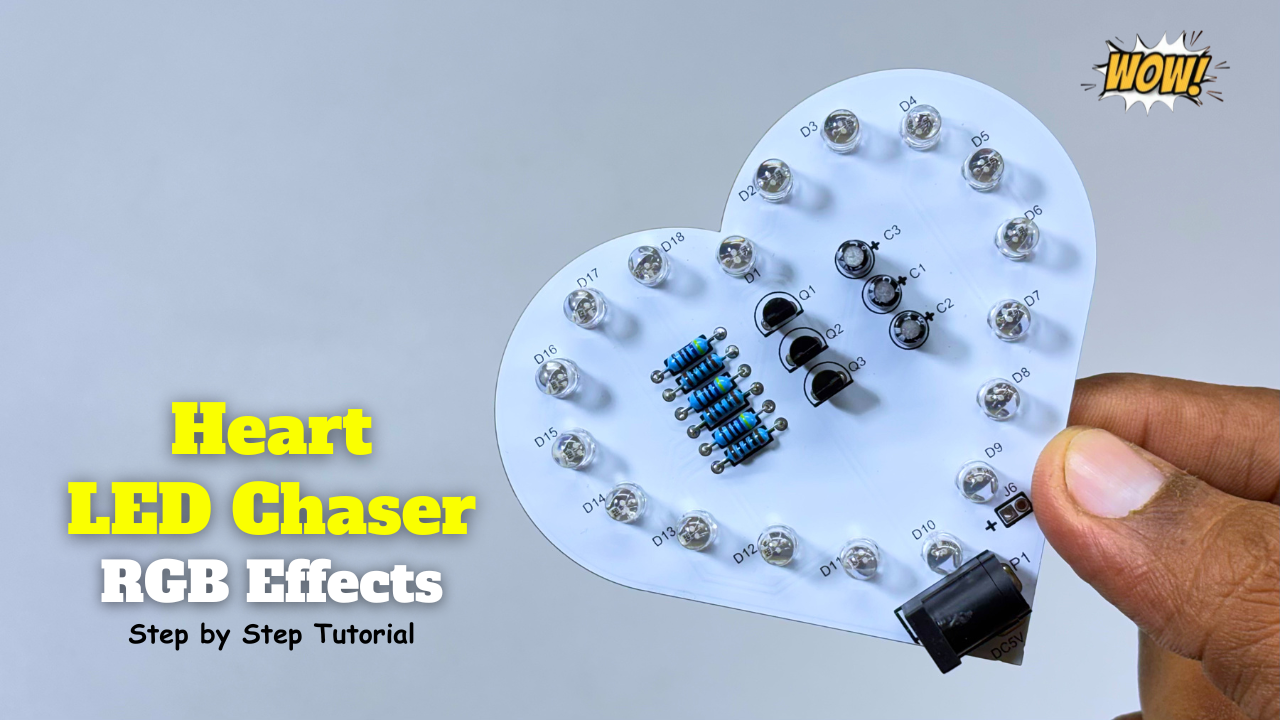Creating fun and eye-catching LED projects is one of the best ways to learn electronics. In this blog, we’ll walk through the process of building a heart-shaped LED chaser circuit using 9013 transistors. This simple project not only looks beautiful but also teaches important concepts in transistor switching and basic timing circuits.
Components Used:
- 9013 Transistor
- 47uf 16v
- Resistor 10k ohm, 100 ohm
- LED
- Connector
- Power Supply 5v
How It Works
The circuit is based on transistor switching and RC delay networks. Here’s the idea:
- Each 9013 NPN transistor acts as a switch.
- A capacitor and resistor form a delay circuit that controls the ON timing of the next transistor.
- As one transistor turns ON, it lights up a group of LEDs.
- The ON signal is passed to the next stage after a slight delay, creating a “chasing” effect.
The LEDs are arranged in the shape of a heart, and the chaser effect brings them to life in sequence.
Special Thanks to Our Sponser – JLCPCB:
No project is complete without the right tool and materials. That’s why our sponser JLCPCB stepped into provide essential material for the project. JLCPCB is a leading provider of high quality printed circuit board and PCB assembling services.
Simply head over to JLCPCB, Upload your gerber file, select specification and just place your order.
48-Hour Turnaround for 6 Layer PCBs!

Discover Easy, Affordable, and Reliable PCB manufacturing with JLCPCB! Register to get $60 New customer coupons.

How To Order PCB
Circuit Diagram:

Applications and Ideas
- Valentine’s Day gift with personalized messages.
- DIY romantic decoration.
- A cool project for school/college exhibitions.
- Learning sequential circuits using discrete components.
Understanding the 9013 Transistor
The 9013 is a popular NPN bipolar junction transistor (BJT) commonly used in low to medium power switching and amplification applications. It is often used in LED circuits, motor drivers, audio preamps, and signal processing tasks.
Technical Specifications
| Parameter | Value |
|---|---|
| Type | NPN |
| Maximum Collector Current (Ic) | 800 mA |
| Maximum Collector-Emitter Voltage (Vce) | 40 V |
| Maximum Power Dissipation (Ptot) | 625 mW |
| DC Current Gain (hFE) | 40–300 |
| Transition Frequency (ft) | 150 MHz |
| Package Type | TO-92 |
Working Principle
In an NPN transistor like the 9013:
- When a small current flows into the base, it allows a larger current to flow from the collector to the emitter.
- This makes it useful as an electronic switch or amplifier.
Applications
- LED blinking and chaser circuits
- Small motor control
- Signal amplification
- Audio preamplifiers
- Pulse and timer circuits
- DIY electronics and toys
Why Use the 9013?
- It can handle more current (up to 800mA) than other common transistors like BC547 (100mA).
- It’s widely available and inexpensive.
- Suitable for switching multiple LEDs at once.
- Ideal for hobby electronics and educational projects.
Similar Alternatives
If you don’t have a 9013, you can try these alternatives (after checking specs):
- S8050
- 2N2222
- BC337
- C1815 (for lower current loads)
More Projects
-
Meet the Cutebot Pro – The smartest Micro:bit Robot Car!
The CuteBot Pro is a programmable robot-car kit designed for STEAM/robotics education.Key features include: Obstacle Avoiding Car Line Following Car More Projects
-
Create a Stunning Heart LED chaser Circuit with Simple Electronics
An LED chaser is an electronic circuit that lights LEDs one after another in a sequence. It creates a running or chasing light effect commonly seen in decorations and indicators. …
-
Amazing LED Chaser Circuit – Beautiful Decoration Idea
An LED chaser is an electronic circuit that lights LEDs one after another in a sequence. It creates a running or chasing light effect commonly seen in decorations and indicators. …



